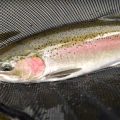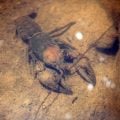How to Tie the Isonychia Soft Hackle
Producer: tightlinevideo
Isonychias, or Isos, are one of my favorite hatches here in the East, mainly because they take place over such a large period of time. We’ll start to see them as early as late June, and all the way into November. The trout seem to just get used to them being around as a food source. The nymphs are easily identified by their elongated flat abdomens, short frilly tails and, many times, a white stripe down their back. They’re most often a brownish-maroon color with mottled legs. Isonychia Nymphs are truly remarkable swimmers and I believe that’s why swung soft hackles, like this one, do such an amazing job of imitating them. This particular pattern owes a lot to one of Preston Jenning’s patterns, but adds some more modern elements.
The fly starts with a Fulling Mill 5085 nymph hook in size 12. Size 10’s will also work, as these are fairly large bugs. After getting the hook firmly secured in the jaws of my tying vise, I load a bobbin with a spool of brown UTC 70. Black or maroon-colored thread are good choices as well. Get the thread started on the hook shank, leaving a bit of space behind the back edge of the hook eye. After taking a dozen or so wraps rearward, snip off the excess tag.
Small-sized, gold Ultra wire is used to rib and segment the abdomen of the fly. An 8” length is enough to make numerous Iso Soft Hackles. Lay one end of the wire on top of the hook shank, above your tying thread, and begin taking touching thread wraps rearward, binding the wire down as you go. Allow the wire to be pushed to the far side of the hook. Anchor it all the way back to the start of the hook bend. Unruly wire can be subdued with a materials clip of your choosing. Advance your tying thread forward to the front end of the wire.
Pheasant tail fibers dyed chocolate brown are used for the tail of the fly. Pull down 6 or so fibers perpendicular to the stem, then pull the stem away to strip them free. It’s a good idea to cut off the little curlies, as they tend to grab on to your tying thread as you wrap. At this point, the tips of the fibers should be reasonably aligned. Measure to form a rather short tail, just a bit more than a hook gap in length. While keeping that measurement, begin binding the fibers to the top of the hook shank with tight wraps of tying thread. It’s important to pull up and toward you on the fibers as you wrap, to ensure they’re bound down on top of the hook shank, rather than being pushed to the far side of the shank. With the fibers anchored all the way to the start of the hook bend, advance your thread forward to about the midpoint of the hook shank. You can then snip the excess butt ends of the pheasant tail fibers off close.
For the stripe down the fly’s back, UTC 140 in white works well. You don’t need much. Begin attaching the thread to the hook shank. Here too, pull up and slightly toward you on the thread as you wrap to keep it centered on top of the shank, all the way back to the base of the tail. Then, once again, advance your thread forward to about the midpoint of the shank.
Although there are many dubbing options for the abdomen of the fly, I’m partial to Isonychia-colored UV2 Fine & Dry dubbing from Spirit River. After removing an ample clump from the packet, pull it apart and put it back together several times to align the fibers. Then, rotate the clump into a vertical orientation which will allow you to pull dubbing from the clump so it’s parallel to your tying thread. Twist on a small amount at a time, leaving the bottom of the dubbing untwisted. This makes it so you can weave in a second clump and make a very cohesive slender noodle. Continue this process down your tying thread until you’ve created a nice, tight, slim noodle about 4” in length. Start taking wraps with the noodle so the dubbing begins right at the base of the tail. Then, take touching to slightly overlapping wraps with the noodle, up the hook shank, all the way to the initial tie-in point. Pull the white thread forward, over top of the body, and anchor it with a few tight wraps of tying thread. Pull the thread back and really lock it down with rearward thread wraps. You can then snip the excess off close. The back of the fly should now look something like this.
Get hold of the gold wire and begin making open spiral wraps with it to both rib and segment the abdomen of the fly, as well as anchor the white stripe to it. These are normal direction wraps, no need to counter wrap here. When you reach your tying thread, use it to firmly anchor the wire then helicopter to break it off close. Make sure your tying thread is positioned right at the front edge of the abdomen for the next step.
Peacock herl is used to form the thorax of the fly. Pull 3 or 4 strands free from the packet, then snip off square a 1/2 inch or so of the brittle tip ends. Begin anchoring the herls to the hook shank with tight wraps of tying thread. Go back over top of the dubbed body just a little and leave your tying thread there. Without twisting the herls, begin wrapping them forward but behind your tying thread, which will help to keep them sandwiched close together. After 3 or 4 turns, anchor the herls with wraps of tying thread and snip the excess off close, ideally leaving a little space behind the back edge of the hook eye.
A single mottled brown hen saddle hackle feather is used to form the soft hackle collar of the fly. This particular patch is absolutely spectacular. Strip off the lower fuzzy longer fibers from both sides of the stem. Ideally you want the lowest fibers left to be about the same length as the hook shank. Now, get hold of the feather by its tip and gently stroke down approximately 1/4” of the lower fibers to expose the tip. You can then snip the entire tip off close. Give your bobbin a good counterclockwise spin, as if you’re looking down on it, so the first wrap of tying thread will want to jump rearward and catch not only the stem but 3 or 4 fibers on both sides of it. This makes for a more robust connection than binding down the stem alone. End with your tying thread right at the back edge of the hook eye. Pull up on the stem and preen the fibers rearward as you begin taking touching wraps forward with the feather. After only 2 wraps, anchor the stem and any excess fibers with wraps of tying thread. Once done, snip the excess stem off close. Any forward-pointing fibers can be preened rearward then pinned back with thread wraps.
Pick up your whip finish tool and use it to do a 5 or 6 turn, back to front whip finish, seat the knot well and snip or cut your tying thread free. Try to keep the head as small as possible as it’s more aesthetically pleasing. A drop of head cement, here Sally Hansen Hard as Nails, applied to the thread wraps will ensure they don’t come unraveled. It’s always a good idea to use a bodkin to make sure the hook eye is clear of adhesive.
And that’s the Isonychia Soft Hackle. Swung down and across, it’s not only effective but an absolute joy to fish.
How to Tie the Isonychia Smoke Jumper
How to Tie the Kintner Boy











